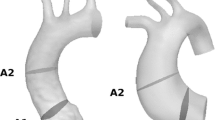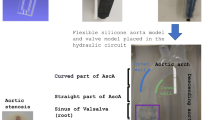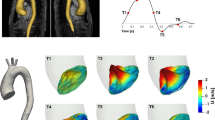Abstract
Blood flow in the aorta has been of particular interest from both fluid dynamics and physiology perspectives. Coarctation of the aorta (COA) is a congenital heart disease corresponding to a severe narrowing in the aortic arch. Up to 85 % of patients with COA have a pathological aortic valve, leading to a narrowing at the valve level. The aim of the present work was to advance the state of understanding of flow through a COA to investigate how narrowing in the aorta (COA) affects the characteristics of the velocity field and, in particular, turbulence development. For this purpose, particle image velocimetry measurements were conducted at physiological flow and pressure conditions, with three different aorta configurations: (1) normal case: normal aorta + normal aortic valve; (2) isolated COA: COA (with 75 % reduction in aortic cross-sectional area) + normal aortic valve and (3) complex COA: COA (with 75 % reduction in aortic cross-sectional area) + pathological aortic valve. Viscous shear stress (VSS), representing the physical shear stress, Reynolds shear stress (RSS), representing the turbulent shear stress, and turbulent kinetic energy (TKE), representing the intensity of fluctuations in the fluid flow environment, were calculated for all cases. Results show that, compared with a healthy aorta, the instantaneous velocity streamlines and vortices were deeply changed in the presence of the COA. The normal aorta did not display any regions of elevated VSS, RSS and TKE at any moment of the cardiac cycle. The magnitudes of these parameters were elevated for both isolated COA and complex COA, with their maximum values mainly being located inside the eccentric jet downstream of the COA. However, the presence of a pathologic aortic valve, in complex COA, amplifies VSS (e.g., average absolute peak value in the entire aorta for a total flow of 5 L/min: complex COA: = 36 N/m2; isolated COA = 19 N/m2), RSS (e.g., average peak value in the entire aorta for a total flow of 5 L/min: complex COA: = 84.6 N/m2; isolated COA = 44 N/m2) and TKE (e.g., average peak value in the entire aorta for a total flow of 5 L/min: complex COA: = 215 N/m2; isolated COA = 100 N/m2). This demonstrates that the pathological aortic valve strongly interacts with the COA. Findings of this study indicate that the presence of both a COA and a pathological aortic valve significantly alters hemodynamics in the aorta and thus might contribute to the progression of the disease in this region. This study can partially explain the complications associated in patients with COA, in the presence of a pathological aortic valve and the consequent adverse outcome post-surgery.











Similar content being viewed by others
References
Abbott ME (1928) Coarctation of the aorta of adult type; statistical study and historical retrospect of 200 recorded cases with autopsy; of stenosis or obliteration of descending arch in subjects above age of two years. AHJ 3:574–618
Agrawal Y, Talbot L, Gong K (1978) Laser anemometer study of flow development in curved circular pipes. J Fluid Mech 85:497–518
Arzani A, Dyverfeldt P, Ebbers T, Shadden S (2012) In vivo validation of numerical prediction for turbulence intensity in an aortic coarctation. BMES 40:860–870
Barker AJ, Lanning C, Shandas R (2010) Quantification of hemodynamic wall shear stress in patients with bicuspid aortic valve using phase-contrast MRI. Ann Biomed Eng 38:788–800
Beaton AZ, Nguyen T, Lai WW, Chatterjee S, Ramaswamy P, Lytrivi ID, Parness IA, Srivastava S (2009) Relation of coarctation of the aorta to the occurrence of ascending aortic dilation in children and young adults with bicuspid aortic valves. Am J Cardiol 103:266–270
Berger SA, Jou LD (2000) Flow in stenotic vessels. Annu Rev Fluid Mech 32:347–382
Berger A, Talbot L, Yao LS (1983) Flow in curved pipes. Annu Rev Fluid Mech 15:461–512
Boiron O, Deplano V, Pelissier R (2007) Experimental and numerical studies on the starting effect on the secondary flow in a bend. J Fluid Mech 574:109–129
Braverman AC, Guven H, Beardslee MA, Makan M, Kates AM, Moon MR (2005) The bicuspid aortic valve. Curr Probl Cardiol 30:470–522
Brickner ME, Hillis LD, Lange RA (2000) Congenital heart disease in adults. N Engl J Med 342:256–263
Chandran KB, Vigmostad SC (2013) Patient-specific bicuspid valve dynamics: overview of methods and challenges. J Biomech 46:208–216
Chang LJ, Tarbell J (1985) Numerical simulation of fully developed sinusoidal and pulsatile physiological flow in curved tubes. J Fluid Mech 161:175–198
Conti CA, Corte AD, Votta E, Viscovo LD, Bancone C, De Santo LS, Redaelli A (2010) Biomechanical implications of the congenital bicuspid aortic valve: a finite element study of aortic root function from in vivo data. J Thorac Cardiovasc Surg 140:890–896
De Mey S, Segers P, Coomans I, Verhaaren H, Verdonck P (2001) Limitations of Doppler echocardiography for the post-operative evaluation of aortic coarctation. J Biomech 34:951–960
Dean WR (1927) Note on the motion of fluid in a curved pipe. Philos Mag 20:208–223
Dean WR (1928) The streamline motion of fluid in a curved pipe. Philos Mag 30:673–693
DeGroff CG, Orlando W, Shandas R (2003) Insights into the effect of aortic compliance on Doppler diastolic flow patterns seen in coarctation of the aorta: a numeric study. JASE 16:162–169
Deplano V, Siouffi M (1990) Experimental and numerical study of pulsatile flows through stenosis: wall shear stress analysis. J Appl Biomech 32:1081–1090
Dyverfeldt P, Escobar Kvitting JP, Sigfridsson A, Engvall J, Bolger AF, Ebbers T (2008) Assessment of fluctuating velocities in disturbed cardiovascular blood flow: in vivo feasibility of generalized phase-contrast MRI. Magn Reson Imaging 28:655–663
Etebari A, Vlachos PP (2005) Improvements on the accuracy of derivative estimation from DPIV velocity measurements. Exp Fluids 39:1040–1050
Fung YC (1981) Mechanical properties of living tissues. Springer, New York, p 468p
Guivier-Curien C, Deplano V, Bertrand E (2009) Validation of a numerical 3-D fluid–structure interaction model for a prosthetic valve based on experimental PIV measurements. Med Eng Phys 31:986–993
Hamakiotes CC, Berger SA (1998) Fully developed pulsatile flow in a curved pipe. J Fluid Mech 195:23–55
Hope MD, Meadows AK, Hope TA, Ordovas KG, Saloner D, Reddy GP, Alley MT, Higgins CB (2010a) Clinical evaluation of aortic coarctation with 4D flow MR imaging. Magn Reson Imaging 31:711–718
Hope MD, Hope TA, Meadows AK, Ordovas KG, Urbania TH, Alley MT, Higgins CB (2010b) Bicuspid aortic valve: four-dimensional MR evaluation of ascending aortic systolic flow patterns. Radiology 255:53–61
Huang RF, Yang TF, Lan YK (2010) Pulsatile flows and wall-shear stresses in models simulating normal and stenosed aortic arches. Exp Fluids 48:497–508
Ito H (1987) Flow in curved pipes. JSME Int J 30:543–552
Jin S, Oshinski J, Giddens DP (2003) Effects of wall motion and compliance on flow patterns in the ascending aorta. J Biomech Eng 125:347–354
Keane RD, Adrian RJ (1990) Optimization of particle image velocimeters. I. Double pulsed systems. Meas Sci Technol 1:1202
Keshavarz-Motamed Z, Kadem L (2010) 3D pulsatile flow in a curved tube with coexisting model of aortic stenosis and coarctation of the aorta. Med Eng Phys 3:315–324
Keshavarz-Motamed Z, Garcia J, Pibarot P, Larose E, Kadem L (2011) Modeling the impact of concomitant aortic stenosis and coarctation of the aorta on left ventricular workload. J Biomech 44:2817–2825
Keshavarz-Motamed Z, Garcia J, Maftoon N, Bedard E, Chetaille P, Kadem L (2012) A new approach for the evaluation of the severity of coarctation of the aorta using Doppler velocity index and effective orifice area: in vitro validation and clinical implications. J Biomech 45:1239–1245
Keshavarz-Motamed Z, Garcia J, Kadem L (2013) Fluid dynamics of coarctation of the aorta and effect of bicuspid aortic valve. PLoS ONE 8:e72394
Kirsh MM, Perry B, Spooner E (1977) Management of pseudoaneurysm following patch grafting for coarctation of the aorta. J Thorac Cardiovasc Surg 74:636–639
LaDisa F, Figueroa CA, Vignon-Clementel IE, Kim HJ, Xiao N, Ellwein LM, Chan FP, Feinstein JA, Taylor CA (2011) Computational simulations for aortic coarctation: representative results from a sampling of patients. J Biomech Eng 33:091008
Lantz J, Ebbers T, Engvall J, Karlsson M (2013) Numerical and experimental assessment of turbulent kinetic energy in an aortic coarctation. J Biomech 46:1851–1858
Levine JC, Sanders SP, Colan SD, Jonas RA, Spevak PJ (2001) The risk of having additional obstructive lesions in neonatal coarctation of the aorta. Cardiol Young 11:44–53
Liu S, Tang D, Tieche C, Alkema P (2003) Pattern formation of vascular smooth muscle cells subject to nonuniform fluid shear stress: mediation by gradient cell density. Am J Physiol Heart Circ Physiol 285:1072–1080
Markl M, Arnold R, Hirtler D, Muhlen CVZ, Harloff A, Langer M, Hennig J, Frydrychowicz A (2009) Three-dimensional flow characteristics in aortic coarctation and poststenotic dilatation. Comput Assist Tomogr 33:776–778
Meierhofer C, Schneider EP, Lyko C, Hutter A, Martinoff S, Markl M, Hager A, Hess J, Stern H, Fratz S (2012) Wall shear stress and flow patterns in the ascending aorta in patients with bicuspid aortic valves differ significantly from tricuspid aortic valves: a prospective study. Eur Heart J Cardiovasc Imaging. doi:10.1093/ehjci/jes273
Menon A, Eddinger TJ, Wang H, Wendell DC, Toth JM, LaDisa JF (2012) Altered hemodynamics endothelial function, and protein expression occur with aortic coarctation and persist after repair. Am J Physiol Heart Circ Physiol 303:1304–1318
Mori D, Yamaguchi T (2002) Computational fluid dynamics modeling and analysis of the effect of 3-D distortion of the human aortic arch. Comput Method Biomech 5:249–260
Mullin T, Greated CA (1980) Oscillatory flow in curved pipes, part 1: the developing flow case. J Fluid Mech 98:383–395
Naruse T, Tanishita K (1996) Large curvature effect of pulsatile flow in a curved tube. J Biomech 118:180–186
Nichols WW, O’Rourke MF (2005) McDonald’s blood flow in arteries: theoretical, experimental and clinical principles. Hodder Arnold Publication, New York
Oliver JM, Gallego P, Gonzalez A, Aroca A, Bret M, Mesa JM (2004) Risk factors for aortic complications in adults with coarctation of the aorta. JACC 44:1641–1647
O’Rourke MF, Cartmill TB (1971) Influence of aortic coarctation on pulsatile hemodynamics in the proximal aorta. Circulation 44:281–292
Parikh SR, Hurwitz RA, Hubbard JE, Brown JW, King H et al (1991) Preoperative and postoperative ‘aneurysm’ associated with coarctation of the aorta. J Am Coll Cardiol 17:1367–1372
Parks WJ, Ngo TD, Plauth WH Jr, Bank ER, Shepparda SK et al (1995) Incidence of aneurysm formation after Dacron patch aortoplasty repair for coarctation of the aorta: long-term results and assessment utilizing magnetic resonance angiography with three-dimensional surface rendering. J Am Coll Cardiol 26:266–271
Pedley TJ (1980) The fluid mechanics of large blood vessels. Cambridge University Press, London
Pedley TJ, Kamm RD (1988) The effect of secondary motion of axial transport in oscillatory tube flow. J Fluid Mech 193:347–367
Raffel M, Willert C, Kompenhans J (1998) Particle image velocimetry. Springer, Berlin
Richter Y, Elazer ER (2006) Cardiology is flow. Circulation 113:2679–2682
Roos-Hesselink JW, Scholzel BE, Heijdraet RJ, Spitaels SEC, Meijboom FJ, Boersma E, Bogers AJJC, Simons ML (2003) Aortic valve and aortic arch pathology after coarctation repair. Heart 89:1074–1077
Saikrishnan N, Yap CH, Milligan NC, Vasilyev NV, Yoganathan AP (2012) In vitro characterization of bicuspid aortic valve hemodynamics. Ann Biomed Eng 40:1760–1775
Seifert BL, DesRochers K, Ta M, Giraud G, Zarandi M, Gharib M, Sahn DJ (1999) Accuracy of Doppler methods for estimating peak-to-peak and peak instantaneous gradients across coarctation of the aorta: an in vitro Study. J Am Soc Echocardiogr 12:744–753
Shahcheraghi N, Dwyer HA, Cheer AY, Barakat AI, Rutaganira T (2003) Unsteady and three-dimensional simulation of blood flow in the human aortic arch. J Biomech Eng 124:378–387
Sievers HH, Schmidtke C (2007) A classification system for the bicuspid aortic valve from 304 surgical specimens. J Thorac Cardiovasc Surg 133:1226–1233
Siggers J, Waters S (2008) Unsteady flows in pipes with finite curvature. J Fluid Mech 600:133–165
Sudo K, Sumida M, Yamane R (1992) Secondary motion of fully developed oscillatory flow in a curved pipe. J Fluid Mech 237:189–208
Sumida M (2007) Pulsatile entrance flow in curved pipes: effect of various parameters. Exp Fluids 43:949–958
Swanson CJ, Stalp SR, Donnelly RJ (1993) Experimental investigation of periodic flow in curved pipes. J Fluid Mech 256:69–83
Talbot L, Gong K (1983) Pulsatile entrance flow in a curved pipe. J Fluid Mech 127:1–25
Unger EL, Marsan RE (1977) Ruptured aneurysm 20 years after surgery for coarctation of the aorta. Am J Roentgenol 129:329–330
Viscardi F, Vergara C, Antiga L, Merelli S, Veneziani A, Puppini G, Faggian G, Mazzucco A, Luciani GB (2010) Comparative finite element model analysis of ascending aortic flow in bicuspid and tricuspid aortic valve. Artif Organs 34:1114–1120
Vriend JW, Mulder BJ (2005) Late complications in patients after repair of aortic coarctation: implications for management. Int J Cardiol 101:399–406
Wen CH, Yang AS, Tseng LY, Chai JW (2010) Investigation of pulsatile flow field in healthy thoracic aorta models. Ann Biomed Eng 38:391–402
Westerweel J (2000) Theoretical analysis of the measurement precision in particle image velocimetry. Exp Fluids 29:3–12
Xu J, Shiota T, Omoto R, Zhou X, Kyo S, Ishii M, Rice MJ, Sahn DJ (1997) Intravascular ultrasound assessment of regional aortic wall stiffness, distensibility, and compliance in patients with coarctation of the aorta. Am Heart J 134:93–98
Yao LS, Berger SA (1975) Entry flow in a curved pipe. J Fluid Mech 67:177–196
Zalosh RG, Nelson WG (1991) Pulsating flow in a curved tube. J Fluid Mech 59:693–705
Zarandi MM (2000) Steady and pulsatile flow in curved vessels. Dissertation, California Institute of Technology
Author information
Authors and Affiliations
Corresponding author
Rights and permissions
About this article
Cite this article
Keshavarz-Motamed, Z., Garcia, J., Gaillard, E. et al. Effect of coarctation of the aorta and bicuspid aortic valve on flow dynamics and turbulence in the aorta using particle image velocimetry. Exp Fluids 55, 1696 (2014). https://doi.org/10.1007/s00348-014-1696-6
Received:
Revised:
Accepted:
Published:
DOI: https://doi.org/10.1007/s00348-014-1696-6




